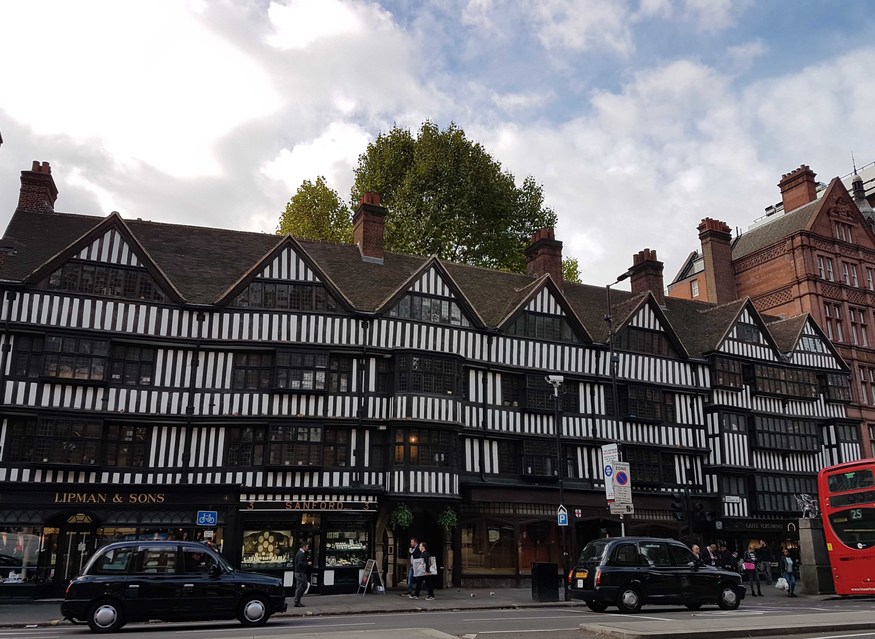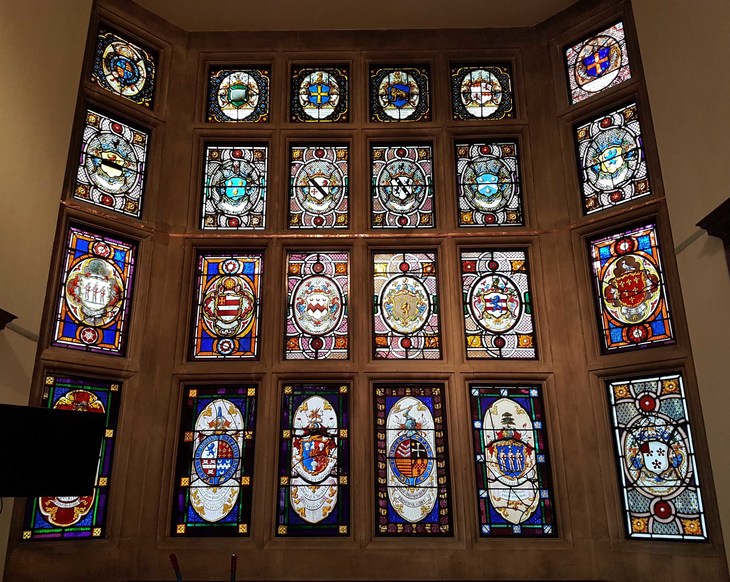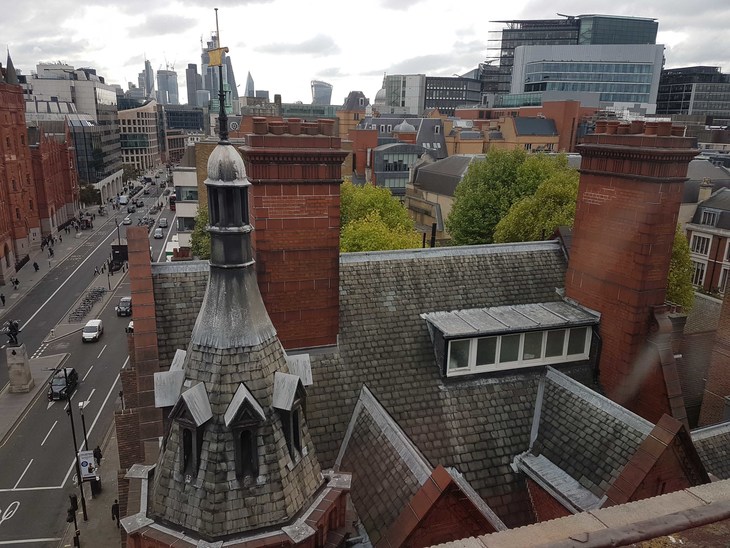Everyone knows Staple Inn, even if they don’t know what’s it’s called. It’s this one:

It used to be in the London Borough of Camden but one day, back in 1994, the building miraculously moved. Courtesy of arcane boundary changes, Staple Inn now lives back home in the City of London.
One of just four original Tudor timber-framed buildings left in the City, Staple Inn shouldn’t have survived at all. Plague, fire, more fire and fire-bombs have all had a pop. But that Grade I-listed frontage stays. Behind it…well, we’ll get to that.

The name ‘Staple’ probably comes from warehouses built to facilitate Edward I’s 1275 tax on wool. Le Stapled Halle (not the present building) saw brisk action taxing sacks of the fluffy stuff arrive from the country, export to the low countries then return as woven cloth, and very lucrative it was too... for a while.
Rats — and their fleas — love wool. What could make a comfier channel crossing than snuggling down in a ships’ hold full of fabric? By the mid-14th century every consignment of newly-woven cloth returning from the continent came with a free gift: plague.

The Black Death did for the king’s nice little earner. English survivors stopped exporting their wool, weaving it at home instead, and the Inn experienced its first slump.
The coming of Law to Staple Inn was pretty much inevitable. Inns of Apprentices of the Law, later known as Inns of Court, were springing up around the area, now the ‘third universitie’ after Oxford and Cambridge. It’s probable the Chancery (Lord Chancellor’s) Court settled disputes at le Stapled Halle and in 1375 Staple Inn became an Inn of Chancery itself.
In days before food was plentiful for all, many lawyers had skinny backsides and those benches were hard. Some people started using the old woolsacks as cushions. The king thought this was a great idea and soon made everyone sit on woolsacks while performing legal duties.

The first Great Hall, in a courtyard behind that famous black and white façade, was built in 1581. Given the horrors that would happen to it over the next four centuries it’s amazing any of the stunning stained glass survives; thankfully it was taken out and stored in the cellars during the second world war.

The Great Fire of London stopped just before it reached Staple Inn. Nevertheless, afterwards the authorities weren’t taking any chances and for the next couple of centuries the half-timbered Tudor front was smarmed with ‘fireproof’ plaster.

Staple Inn was lived in by regular folk until relatively recently; hence mod-cons like lead water pumps.

Holborn was dirty, smelly and LOUD — not least because of its next-door neighbour, Middle Row, which had been built bang in the centre of the road, clogging up traffic and plunging Staple Inn into darkness. The competing buildings’ gables were so close they nearly met. Distances between modern buildings aren’t much better…

Between 1729 and 1780, Staple Inn was a building site, gradually renovating each dwelling. The hall had to be rebuilt, too, after an all-consuming fire in 1756. No wonder Samuel Johnson only lived at Number Three for a few months in 1759 while he was writing Rasselas. The racket must have driven him crazy. At least he knew the time.

A gigantic clock in the minstrel’s gallery of the hall, complete with two massive weights in special channels in the wall (remember these…) acquired an extra two faces in 1757 as part of the upgrade.

Outside, life remained as normal. Drunken law students, ruffians, vagabonds, thieves (and their fences) barged around the streets, though even they got out of the way of the out-of-town drovers stampeding their cattle to Old Smithfield Market, then 500 yards away.

Somehow, however, Staple Inn did manage to find some peace and quiet. So much so that Charles Dickens described it in The Mystery of Edwin Drood as an escape from the ‘clashing streets’ of London: “It imparts to the relieved pedestrian the sensation of having put cotton in his ears and velvet soles on his boots,” he wrote.
Anthony Trollope begged to disagree. Unimpressed by what John Stow’s 1631 General Chronical of England described it as ‘the Fayrest Inne of Chauncery,’ he found the place ‘somewhat dingy,” though he might have changed his mind if he’d waited until 1867 when Middle Row was finally demolished.

Staple Inn was, however, past its best. It came up for auction in 1886 and no one really wanted it. After limping the price to £68,000 the auctioneer finally banged his gavel to insurance giants Prudential.

They’d just employed architect Alfred Waterhouse to build their flagship HQ down the road; now they got him to restore Staple Inn.

The newly-formed SPAB objected to Waterhouse removing the 17th Century ‘fireproof plaster’ but most people liked the revealed half-timber, especially when he also reinstated a couple of original Tudor bow-windows he’d found knocking around the cellar.
Staple Inn has been home to the Institute and Faculty of Actuaries since 1887.

In the 18th Century, actuaries (from the ancient Roman actuarius, meaning administrative official) were the first people to use mathematics to calculate the probability and risks associated with future events, making them very handy chaps to know if you’re in healthcare, pensions, insurance, banking, investment or just need someone to explain compound interest.

In 1901 Prudential, seeing their tenants expanding, decided to expand the property too. Alfred Waterhouse wanted buff terracotta for Staple Buildings, but the Pru kicked up, so he used the same red brick as their HQ down the road.

Things settled down again until one day in 1936. Witnesses reported an almighty explosion, but no one could find its source. They eventually discovered one of the clock’s weights had snapped from its cable and, inside its wall-channel, had fallen its full height from the Minstrel’s Gallery straight through the cellar, landing three feet into the soil below.

It was a wake-up call. Looking at the entire building, conservators realised it was a death-trap.

Once again Staple Inn was refurbished and, in the new age of Archaeology, they actually took notice of what they found. Hidden parchments. Coins. A candle-snuffer. A ladies’ patten shoe. All now in a small museum case in the hall’s annex.

Most importantly, the Tudor frontage, now a mere wafer, was reinforced with 20th Century steel. It was completed in 1938, just in time for, cough, the second world war.
The conservators’ hearts must have sunk at the news, but that steel saved the front of Staple Inn. In 1941 fire watchers living in the basement heaved a sigh of relief on putting out a fire from an incendiary bomb. In 1944 they weren’t so lucky. Hearing the doodlebug’s engine cut out, three people legged-it to the shelter. Two – the night porter and the Inn porter – made it. The third, a woman who had worked for the Inn for 40 years, didn’t.

The survivors were dug out by some passing GIs but Staple Inn’s hammer-beamed hall had collapsed in its entirety.
Original beams were rescued and reused in yet another rebuild, but at least there were photos and paintings for accuracy this time, even if, as with the strange little carved wooden towers nestling inside the corbels, no one actually knows what some things were ever for.

Incredibly, the original clock workings were reusable and someone found a couple of battered busts of actuarial luminaries and the silver head of the Inn’s ceremonial mace in the rubble.

One fireplace has a pair of sculpted figures — a somewhat battered Tudor centaur and his friend, rather neater round the beard.



However black and white and gorgeous that façade may be, you’ll not see much behind it these days.

Dry-lined and plasterboarded, it’s just offices. But step through the archway into the cobbled courtyard, and Charles Dickens’ velvet-soled boots still come into play.

Step further, into the quiet realms of Staple Inn’s immaculate garden, filled with figs, roses and a locust bean tree, and the City melts into another, world, in some ways as mysterious today as ever: the Inns of Court.

Staple Inn’s Great Hall is still used by the Institute and Faculty of Actuaries, and can also be hired for corporate events, by emailing [email protected]



